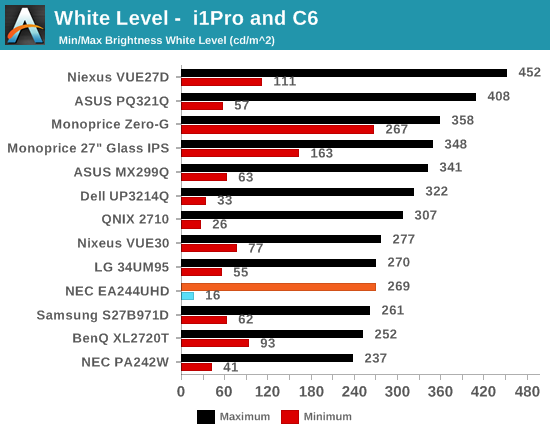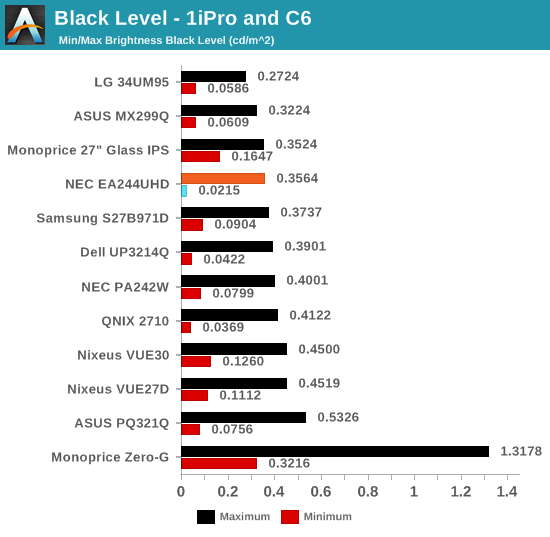NEC EA244UHD Review
by Chris Heinonen on August 7, 2014 2:30 PM ESTBrightness and Contrast
For all of the measurements I enabled the display uniformity option. This can reduce brightness and contrast ratio, but it also produces a more uniform image which I believe is worth the tradeoff. Given the target for the EA244UHD I feel most people would also leave this enabled.
The maximum light output with this enabled is only 269 cd/m2. Setting the backlight to minimum drops this all the way down to 16 cd/m2. This is a very wide range but it's not incredibly bright. Most people using the EA244UHD probably have some sort of light control but if you don’t, bright sunlight will wash it out pretty well.

With an IPS panel and uniformity compensation, black levels are what I expect to see from an NEC display. They are okay but not excellent. NEC could improve these by using a VA-panel, but that leads to sacrifices in off-angle viewing. Instead of uniformity compensation, NEC could use some sort of dimming system to improve blacks, but those almost always harm image quality.

Due to those so-so black levels we get a contrast ratio right around 750:1. IPS panels can do 1,000:1 or almost 1,200:1 now, but not with the uniformity compensation feature. When we look at display uniformity later we can see if this is worth the tradeoff that NEC has made.

This section could have been copied almost verbatim from any other NEC monitor review I have done. The EA244UHD isn’t as bright or punchy as other IPS displays, but it might offer better uniformity because of it. This is the compromise NEC has always made before, and in the past it has proven to be worthwhile.










57 Comments
View All Comments
DanNeely - Thursday, August 7, 2014 - link
Does NEC still use much larger than normal boxes? My 3090's box was several inches larger in every dimension than the box that a friends 30" Dell monitor came in.cheinonen - Thursday, August 7, 2014 - link
Yes, because they ship them with the stand attached where the Dell ones need to be attached (a 10 second process). The Dell box is certainly smaller, and Dell also uses good packaging (all cardboard, easy to recycle but still sturdy). They are really the two best at packaging monitors by far.NECDisplaySolutions - Friday, August 8, 2014 - link
The NEC Display Solutions box size is 25.7in. (W) x 19.6 in. (H) x 10.5 in. (D).Death666Angel - Thursday, August 7, 2014 - link
The wrong monitors seems to be highlighted in the power draw chart. :)Good review otherwise, out of my price range though and I like 1440 with 110Hz IPS and near zero input lag just fine for my needs. :D
cheinonen - Thursday, August 7, 2014 - link
Thanks, fixed the graph!boblozano - Thursday, August 7, 2014 - link
Have the dell 24 driven from a mac pro, using "best for display" scaled resolution in 10.10. Did a quick calibration, and this just works. Best monitor I've ever used on a stationary computer, hard not to keep smiling. At this point I think (multiple) 4k 24s are the sweet spot, at least if the os and apps handle scaling well.nevertell - Friday, August 8, 2014 - link
But what could handle a set of three 4K monitors ?B3an - Thursday, August 7, 2014 - link
I'm so sick of these 4k monitors that are not even 30".A 30 - 36" 4k monitor would be perfect.
DanNeely - Thursday, August 7, 2014 - link
in the 30 inch class I'd really rather have a 5k monitor. As long as legacy apps are in frequent use 2:1 scaling options will have major advantages; and a 24" 2k monitor does 2:1 perfectly as an upgrade from 1080p.nevertell - Friday, August 8, 2014 - link
A 2k monitor as in 3820x2160 ? Or 2560x1440 ? Because the latter won't do 2:1 scaling. To scale something 2:1 on a monitor, you've got to have 4 times as many pixels.